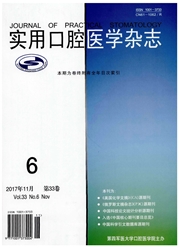

 中文摘要:
中文摘要:
目的:建立适用于免疫学研究的口腔黏膜软组织移植(oral mucosal soft tissue transplant,OMT)模型并探讨其主要的免疫病理学特征。方法:将0.3~0.5 cm的Balb/C小鼠全舌组织移植到Wistar大鼠颊黏膜下。连续观察移植后90 d内其一般健康状况、生存率、体重变化、移植局部症状及脾脏肿胀等大体情况;检测血常规,血清C3、C4、IgA、IgG及IgM含量;组织学观察移植局部变化并在此基础上提出OMT的病理学分级标准。结果:该模型局部急性排斥症状明显,主要为颊黏膜肿胀渗出、引流淋巴结肿胀、中性粒细胞密集浸润及移植物破坏等。上述症状始于术后1 d,7~15 d到达高峰,而后逐渐缓解,慢性炎细胞替代中性粒细胞并呈修复状态。病理分级相应从G3、G4、G2到G0。其全身症状不显著。结论:初步建立OMT模型并明确其免疫病理特征:天然免疫与获得性免疫协同作用;急性排斥占主导。
 英文摘要:
英文摘要:
Objective: To establish an oral mucosal soft tissue transplantation(OMT) model for the study of its basic immunopathological characteristics.Methods: Full tongue samples with the size of 0.5 cm×0.3 cm×0.2 cm from Balb/C mice were xenotransplanted into the sub-buccal mucosa of 80 Wistar rats.Other 80 rats underwent sham operation and 20 without operation were used as the controls.Gross observation such as general health,survival rates,body weight,swelling and pyorrhea of the buccal mucosa,swelling of submandibular lymph node(SMLN) and spleen were recorded.Examination of blood routine,C3,C4,IgA,IgG,and IgM levels in serum and histological observation of oral mucosa were performed.In addition,a pathological grading approach of OMT was proposed.Results: Local acute rejection symptoms of OMT were predominant and mainly reflected by swelling and pyorrhea,neutrophils infiltration,destruction of the xenograft of buccal mucosa and swelling of SMLN.The symptoms appeared from day 1 on;then became distinguished and got acrophase from day 7 to day 15;subsequently,declined gradually and other adaptive immune cells instead of neutrophils infiltration appeared,tissue repair became obvious.Pathological grade3(G3),G4 and G2 to G0 were predominant in above periods respectively.General symptom in OMT group showed no differences compared with the controls during the observation period.Conclusion: Both innate immune system(IIS) and adaptive immune system(AIS) play roles in OMT;acute rejection is predominant.
 同期刊论文项目
同期刊论文项目
 同项目期刊论文
同项目期刊论文
 期刊信息
期刊信息
